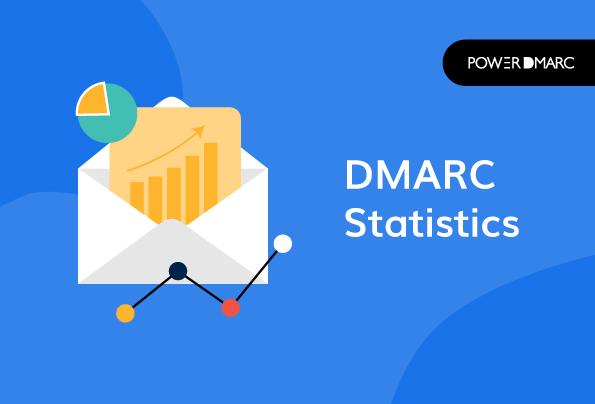An email is a vital tool for communication and business operations, and understanding email statistics is crucial for maintaining a secure and efficient email system. One important aspect of email statistics is DMARC (Domain-based Message Authentication, Reporting & Conformance) adoption and compliance.
What is DMARC Statistics?
DMARC statistics are data that is collected and reported by email receivers, which can be analyzed by domain owners to understand how their DMARC implementation is working. These statistics can include information on how many messages passed or failed DMARC evaluation, which mechanisms were used for authentication, and which email receivers are sending reports.
DMARC is an email authentication protocol that helps protect against email spoofing and phishing. It provides a mechanism for email receivers to check that incoming messages are from authorized sources, by verifying that the domain of the sender matches the domain of the email’s “From” address. By publishing a DMARC record in their DNS, domain owners can indicate which mechanisms (e.g. SPF, DKIM) are used to authenticate messages sent from their domain, and set policies for how email receivers should handle messages that fail DMARC evaluation.
By analyzing DMARC statistics, domain owners can identify any issues with their email authentication setup, such as misconfigured SPF or DKIM records, and take steps to improve compliance. For example, if a high percentage of messages are failing DMARC evaluation, the domain owner may need to update their SPF or DKIM records to include all authorized sources of email.
In addition, DMARC statistics can also provide insight into the prevalence of email spoofing and phishing attempts. For example, if a large number of messages are failing DMARC evaluation because they are using a different domain than the “From” address, this may indicate that the domain is being targeted by phishers.
Overall, understanding and monitoring DMARC statistics is essential for maintaining the security and integrity of email communications. By analyzing these statistics, domain owners can take steps to improve their email authentication setup and prevent spoofing and phishing attempts. Additionally, by monitoring DMARC statistics over time, they can stay informed about the latest trends and emerging threats in email security.
The need for DMARC statistics
According to a recent study, as of 2021, DMARC adoption has grown significantly, with over 30% of the world’s largest domains now publishing a DMARC record. However, there is still a long way to go, as many smaller domains and organizations have yet to implement DMARC.
In addition to DMARC adoption, it is also important to track DMARC compliance among email receivers. The DMARC standard includes a mechanism for receivers to send aggregate reports to domain owners, providing information on how many messages passed or failed DMARC evaluation, and which mechanisms were used for authentication. By analyzing these reports, domain owners can identify any issues with their email authentication setup and take steps to improve compliance.
Understanding these DMARC statistics is important for ensuring the security and integrity of email communications. In addition, monitoring and analyzing email statistics such as open rates, click-through rates, and bounce rates can help businesses optimize their email campaigns and improve overall email performance.
In conclusion, tracking DMARC statistics and Email statistics is crucial for maintaining a secure and efficient email system. By monitoring DMARC adoption and compliance, as well as other email statistics, businesses can take steps to improve their email system and prevent spoofing and phishing. Additionally, they can improve the overall performance of their email campaigns.
Email Security Statistics and their Importance
Email security statistics include data on the frequency and types of email-based cyber attacks, such as phishing and malware distribution. These statistics can help organizations understand the current threat landscape and take steps to protect themselves from attacks.
It is important to keep track of email security statistics because email is a primary method of communication for businesses and individuals, and email-based attacks can cause significant damage. Phishing scams can lead to financial loss or the theft of sensitive information, while malware can compromise the security of an entire network. By understanding the current threat landscape, organizations can take steps to protect themselves and their customers from these types of attacks.
How can PowerDMARC help you keep track of your DMARC statistics?
PowerDMARC is the ultimate solution for keeping track of your DMARC statistics. PowerDMARC offers a user-friendly interface that allows you to quickly and easily view your DMARC statistics, including the number of passing and failing messages, the percentage of DMARC-compliant messages, and the number of messages that have been rejected or quarantined. You can also view detailed reports on specific domains and IP addresses, making it easy to pinpoint any issues that need to be addressed.
In addition to monitoring your DMARC statistics, PowerDMARC also offers a number of other features that help to improve your email security. For example, it includes SPF flattening to help domain owners with SPF configured, stay under the 10 DNS lookup limit, email header analyzer tool, email authentication hosted services, DMARC aggregate and forensic reporting and much more! Sign up today to access all features.
- SMTP Error Codes Explained - May 20, 2024
- 10 Best Email Protection Tips and Strategies - May 15, 2024
- Can Blockchain Help Improve Email Security? - May 9, 2024
